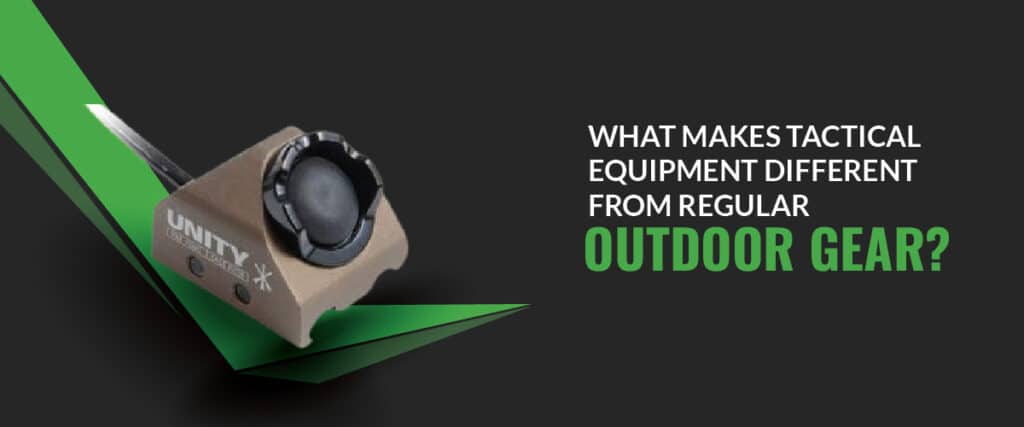What Makes Tactical Equipment Different from Regular Outdoor Gear?

When it comes to preparing for outdoor activities, most people think of backpacks, boots, and camping and cooking supplies. While all of these are suitable for this purpose, tactical gear is in a class of its own. It was designed for extreme conditions and particular use cases, so while it is usable for general use, it was specifically created to handle the operational tempo of military and/or law enforcement, or the skills required to stay alive in survival cases. Tactical gear is separate from outdoor gear and is generally catered more to extreme tasks at hand than caution and ease of use. Knowing the distinctions between tactical equipment and outdoor gear will help you make the right choice for your hiking, camping, or survival needs.
Durability and Build Quality
Tactical equipment is manufactured from durable materials such as ballistic nylon, Cordura, or reinforced composites. These materials are meant to withstand significant wear from environmental exposure or extreme use. In contrast, outdoor gear stresses comfort and weight, making the fatigue of some lighter materials used aimed at weight reduction. Tactical equipment and outdoor gear both have their uses, but tactical equipment is built with greater longevity as well as reliability cognizant of life’s unavoidable situations. For these reasons, tactical equipment is well-suited for more intense environments.
Functionality and Purpose
A tactical backpack may have a MOLLE (Modular Lightweight Load-carrying Equipment) system so users can attach pouches, tools, or hydration packs. A regular outdoor backpack is designed to carry gear in general, such as clothes or food, but without modular attachment capability. The same goes for tactical flashlights, boots, or gloves, all made for combat, rescue, or survival. This advanced level of practicality ensures users are prepared during emergencies, while typical outdoor gear is meant for leisure and recreational use.
Protection and Safety Features
Tactical gear often comes with features meant for safety, such as cut-proof gloves, bullet-proof vests, or heavy-duty boots to protect occupants in hazardous surroundings. Even tactical tents or sleeping bags are tactical for insulation, concealment, and durability in harsh environments. Regular outdoor gear is designed with some protection, but, like sleeping bags or tents, it is primarily designed for comfort. A jacket designed for warmth may provide some safety from the rain and cold, but not at the level a tactical jacket would provide. Tactical gear is suited not only for professionals who conduct their job in high-risk environments but also for outdoor enthusiasts wanting minimal assurance of safety while being outdoors.
Load Capacity and Organization
Tactical gear is also constructed to allow you to carry more gear in a more organized manner. Backpacks, belts, plus vests are usually outfitted with multiple compartments, concealed pockets, and modifiable systems to boost storage space. This type of equipment also allows the user to access necessary items in emergencies with speed. Outdoor gear is easier because often they only have enough space for what they need for food, drink, and clothing. For an amenity external gear, this is acceptable and works better with casual hiking or camping. For military personnel, first responders, or survivalists who require quick access to a knife, radio, or medical supplies, for instance, Tactical gear makes the difference because of superior load-bearing construction.
Camouflage and Stealth Design
Tactical gear will frequently emphasize concealment and stealth. Tactical gear is often produced in earth tones, uses camouflage fabric, or has a matte finish. Contrarily, standard outdoor gear is more vibrant, colorful, and stylish, and frequently uses noticeable colors and patterns to show off and attract attention. Hiking and camping are both outdoor activities, so some hikers and campers prefer to wear bright colors to attract attention and be noticed by rescue teams in case they get lost in the wilderness. Tactical gear is produced with less noticeable intentions on many levels. When you need to camouflage yourself, you will merge in naturally with your environment and use tactical equipment to help you do so.
The Finale
Tactical gear may look similar to standard outdoor gear, but the differences you will find in the products are vast. Tactical gear is made for durability, safety, and versatility: that is, useful for situations that take place in danger or extreme conditions. Note that this type of gear is meant to provide high-quality convenience for normal use. Which one to use? Depending on what you need for the situation. Knowing the tactical gear industry or market can help you make smart decisions regarding your protection and functionality while you enjoy the outdoor experience.
